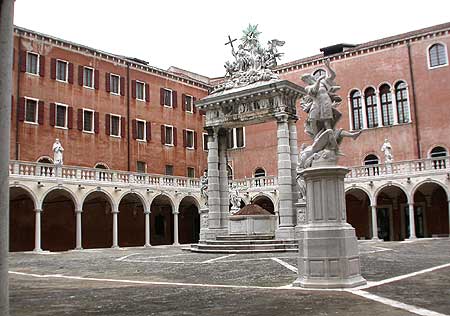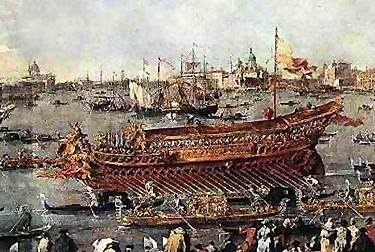Republic of Venice
The Republic of Venice was a city-state in Venetia located in Northeastern Italy, with Venice as its center. Otherwise known as the Most Serene Republic, it existed from the 9th century until the 18th century.
History

Venice, once part of the Byzantine Empire, had established its independence around the ninth century. Trade to the Levant helped Venice become increasingly wealthy in the Middle Ages, and in result was able to expand into the Adriatic Sea. The large merchant fleet and shipyards on the Mediterranean were crucial for the crusaders in the 1200s. With the split from the Byzantine Empire, Venice gained a great deal of territory in the Aegean Sea, including the islands of Crete and Euboea. In addition, Cyprus was annexed to Venice some years later. In the early fifteenth century, Venice began to expand, gaining control of the majority of Venetia, including Verona and Padua. However, it later lost control of the Mediterranean Sea, including some of the most important ports such as those on Crete and Cyprus, to the Ottoman Turks. Because of this, Venice struggled to keep up with it's most crucial competitors, eventually losing to other European countries. The loss of control over the Mediterranean also had a negative affect on shipbuilding, causing many shipyards to close.

Silk production and woolen textiles in Venice increased dramatically throughout the sixteenth century, giving Florence a strong competitor. In addition, the popular Venetian glass was developed at the glassworks of Murano. This exquisite, high quality glass came in a range of different colors and styles to best suite each individual's taste for art and functionality. Chemical industries began producing soap and sugar while the city's attention for its metalwork and printing became increasingly popular.
Politics

In the seventeenth century the Republic of Venice was ruled by a Doge and a council consisting of ten members, otherwise known as the Great Council. The Council, made up of representatives from the rich and noble families in Italy, elected the Doge who helped manage the state's affairs. The Venetians also created a system of checks and balances in order to prevent any one person from using excessive power, potentially harming the republic. Venice, being the republic's center of culture, industry, and trade was managed by professional officials who were required to be citizens of Venice and complete a series of difficult exams. The commoners of Venice were led to believe that they were living under a democracy. They had the power to veto the election of a Doge and were able to vote on minor issues, however, they could not elect the Great Council or replace any aristocratic member. In the 1300s, a Council of Ten became so powerful and secretive that by the 1600s their power had to be limited as to not destroy the politics of the republic.
References
NULL
Bibliography
- Venice: Longest Lasting Republic
- Venice World
- Venetian Republic
- A Brief History of Venice
- Murano Glass
- Archives of the Serenissima